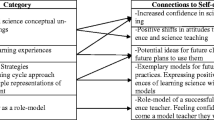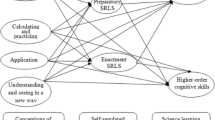Abstract
This study examined relationships between conceptual understanding, self-efficacy, and outcome expectancy beliefs as preservice teachers learned science in a constructivist-oriented methods class. Participants included 49 preservice elementary teachers. Analysis revealed that participants increased in self-efficacy, outcome expectancy, and conceptual understanding. Engaging preservice teachers in hands-on, minds-on activities and discussion were important contributors. Participants reported that they would be inclined to teach from a constructivist perspective in the future. One implication from this study is that increasing the quantity of science content courses that preservice elementary teachers are required to take may not be sufficient to overcome their reluctance to teach science if some of their learning does not take place in a constructivist environment. In our teaching, we have tried to integrate pedagogy with learning science content.
Similar content being viewed by others
References
Abell, S. K., Anderson, M., Ruth, D., & Sattler, N. (1996). What’s the matter: Studying the concept of matter in middle school. Science Scope, 20(1), 18–21.
Ashton, P. (1984). Teacher efficacy: A motivational paradigm for effective teacher education. Journal of Teacher Education, 35(5), 28–32.
Balunuz, M., Jarrett, O. S., & Balunuz, N. (2001, March). Growth of science interest and confidence among Turkish preservice elementary teachers. Paper presented at the Annual Meeting of the National Association for Research of Science Teaching, St Louis, MO.
Bandura, A. (1977). Self-efficacy: Toward a unifying theory of behavioral change. Psychological Review, 84, 191–215.
Bandura, A. (1997). Self-efficacy: The exercise of control. New York: Freeman.
Bandura, A. (2000). Self-efficacy: Foundation of agency. In W. Perrig & A. Grob (Eds.), Control of human behavior, mental processes, and consciousness (pp. 17–33). Mahwah, NJ: Erlbaum.
Bleicher, R. (2001, March). Building science teaching confidence in preservice elementary teachers. Paper presented at the annual meeting of the National Association of Research in Science Teaching, St. Louis, MO.
Bleicher, R. (2002, April). Increasing confidence in preservice elementary teachers. Paper presented at the annual meeting of the American Educational Research Association, New Orleans, LA.
Bleicher, R., & Lindgren, J. (2002). Building confidence in preservice elementary science teachers. In P. Rubba, J. Rye, W. DiBiase, & B. Crawford (Eds.), Proceedings of the 2002 annual international conference of the Association for the Education of Teachers in Science (pp 1593–1606) (ERIC Document Reproduction Service No. ED 465 602).
Brewer, J., & Hunter, A. (1989). Multimethod research: A synthesis of styles. Newbury Park, CA: Sage.
Brooks, J. G., & Brooks, M. G. (1999). In search of understanding: The case for constructivist classroom. Alexandria, VA: Association for Supervision and Curriculum Development.
Cakiroglu, J., & Boone, W. J. (2002). Preservice elementary teachers’ self-efficacy beliefs and their conceptions of photosynthesis and inheritance. Journal of Elementary Science Education, 14(1), 1–14.
Cannon, J. R., & Scharmann, L. C. (1995). Influence of cooperative early field experience on preservice elementary teachers’ science self-efficacy. Science Education, 80, 419–436.
Cantrell, P., Young, S., & Moore, A. (2003). Factors affecting science teaching efficacy of preservice elementary teachers. Journal of Science Teacher Education, 14, 177–192.
Cochran, K. F., & Jones, L. L. (1998). The subject matter knowledge of preservice science teachers. In B. J. Fraser & K. G. Tobin (Eds.), International handbook of science education (pp. 3–25). Dordrecht, The Netherlands: Kluwer Academic Publishers.
Czerniak, C., & Chiarelott, L. (1990). Teacher education for effective science instruction: A social cognitive perspective. Journal of Teacher Education, 41, 49–58.
Darling-Hammond, L. (2000). Solving the dilemmas of teacher supply, demand, and standards: How we can ensure a competent, caring, and qualified teacher for every child. New York: National Commission on Teaching and America’s Future.
Duit, R., & Treagust, D. F. (1998). Learning in science: From behaviorism towards social constructivism and beyond. In B. J. Fraser & K. G. Tobin (Eds.), International handbook of science education (pp. 3–26). Dordrecht, The Netherlands: Kluwer.
Edwards, D., & Mercer, N. (1987). Common knowledge. London: Routledge.
Enochs, L., & Riggs, I. (1990). Further development of an elementary science teaching efficacy belief instrument: A preservice elementary scale. School Science and Mathematics, 90, 694–706.
Frechtling, J., & Sharp, L. (Eds.). (1997). User-friendly handbook for mixed method evaluations. Arlington, VA: National Science Foundation, Division of Research, Evaluation, and Communication (RED 94-52965).
Ginns, I. S., Watters, J. J., Tulip, D. F., & Lucas, K. G. (1995). Changes in preservice elementary teachers’ sense of efficacy in teaching science. School Science and Mathematics, 95, 394–400.
Greene, J. C., & Caracelli, V. J. (1997). Defining and describing the paradigm issue in mixed-method evaluation. New Directions for Evaluation, 74, 5–17.
Guba, E. G., & Lincoln, Y. S. (1989). Fourth generation evaluation. London: Sage.
Haney, J. J., & McArthur, J. (2002). Four case studies of prospective science teachers’ beliefs concerning constructivist teaching practices. Science Education, 86, 783–802.
Hawkins, D. (1990). Defining bridging the gap. In E. Duckworth, J. Easley, D. Hawkins, & A. Henriques (Eds.), Science education: A minds-on approach for the elementary years (pp. 97–139). Hillsdale, NJ: Erlbaum.
Jarrett, O. S. (1999). Science interest and confidence among preservice elementary teachers. Journal of Elementary Science Education, 11(1), 49–59.
Kleinheider, J. K. (1996). Assessment matters. Science & Children, 34(5), 23–26.
Lave, J. (1997). The culture of acquisition and the practice of understanding. In D. Kirshner & J. A. Whitson (Eds.), Situated cognition: Social, semiotic, and psychological (pp. 63–82). Mahwah, NJ: Erlbaum.
Lave, J., & Wenger, E. (1991). Situated learning: Legitimate peripheral participation. Cambridge: Cambridge University Press.
LeCompte, M. D.Preissle, J., & Tesch, R. (1993). Ethnography and qualitative design in educational research (2nd ed.). Orlando, FL: Academic Press.
Lindgren, J., & Bleicher, R. (2003, March). Understanding and Use of the learning cycle and elementary preservice teachers’ self-efficacy. Paper presented at the Annual Meeting of the National Association of Research in Science Teaching, Philadelphia.
Lloyd, J. K., Smith, R. G., Fay, C. L., Khang, G. N., Wah, L. L. K., & Sai, C. L. (1998). Subject knowledge for science teaching at primary level: A comparison of preservice teachers in England and Singapore. International Journal of Science Education, 20, 521–532.
McRobbie, C. J., & Tobin, K. (1995). Restraints to reform: The congruence of teacher and student actions in a chemistry classroom. Journal of Research in Science Teaching, 32, 373–385.
Merriam, S. B. (1998). Qualitative research and case study applications in education. San Francisco: Jossey-Bass.
National Commission on Teaching and America’s Future. (1996). What matters most: Teaching for America’s future. New York: Teachers College Press.
National Research Council. (1996). National science education standards. Washington DC: National Academy Press.
Palmer, D. H. (2002). Factors contributing to attitude exchange amongst preservice elementary teachers. Science Education, 86, 122–138.
Pajares, F. (2002). Self-efficacy beliefs in academic contexts: An outline. Retrieved December, 22, 2003, from http://www.emory.edu/EDUCATION/mfp/efftalk.html.
Ramey-Gassert, L., & Shroyer, M. G. (1992). Enhancing science teaching self-efficacy in preservice elementary teachers. Journal of Elementary Science Education, 4(1), 26–34.
Ramey-Gassert, L., Shroyer, M. G., & Staver, J. R. (1996). A qualitative study of factors influencing science teaching self-efficacy of elementary level teachers. Science Education, 80, 283–315.
Rice, D. C., & Roychoudhury, A. (2003). Preparing more confident preservice elementary science teacher: One elementary science methods teacher’s self-study. Journal of Science Teacher Education, 14, 97–126.
Roth, W. M. (1995). Knowing and interacting: A study of culture, practices, and resources in a grade 8 open-inquiry science classroom guided by a cognitive apprenticeship metaphor. Cognition and Instruction, 13, 73–128.
Scharmann, L. C., & Hampton, C. M. O. (1995). Cooperative learning and preservice elementary teacher science self-efficacy. Journal of Science Teacher Education, 6, 125–133.
Schon, D. A. (1983). The reflective practitioner. New York: BasicBooks.
Schoon, K. J., & Boone, W. J. (1998). Self-efficacy and alternative conceptions of science of preservice elementary teachers. Science Education, 82, 553–568.
Settlage, J. (2000). Understanding the learning cycle: Influences on abilities to embrace the approach by preservice elementary school teachers. Science Education, 84, 43–50.
Shymansky, J. A. (1992). Using constructivist ideas to teach science teachers about constructivist ideas, or teachers are students too! Journal of Science Teacher Education, 3, 53–57.
Silvertsen, M. L. (1993). Transforming ideas for teaching and learning science. Washington, DC: U.S. Department of Education. (ERIC Document Reproduction Service No. ED 362 417).
Stevens, C., & Wenner, G. (1996). Elementary preservice teachers’ knowledge and beliefs regarding science and mathematics. School Science and Mathematics, 96, 2–9.
Strauss, A., & Corbin, J. (1990). Grounded theory: Basics of qualitative research. Newbury Park, CA: Sage.
Tobin, K.(1993). The practice of constructivism in science education. Hillsdale, NJ: Erlbaum.
Tobin, K., & Tippins, D. J. (1993). Constructivism as a referent for teaching and learning. In K. Tobin (Ed.), The practice of constructivism in science education (pp. 3–21). Hillsdale, NJ: Erlbaum.
Tobin, K., Tippins, D. J., & Gallard, A. J. (1994). Research on instructional strategies for teaching science. In D. L. Gabel (Ed.), Handbook on research in science teaching and learning (pp. 45–93). Upper Saddle River, NJ: Merrill/Prentice Hall.
Tosun, T. (2000). The impact of prior science course experience and achievement on the science teaching self efficacy of preservice elementary teachers. Journal of Elementary Science Education, 12(2), 21–31.
Tschannen-Moran, M., Hoy, A., & Hoy, W. (1998). Teacher efficacy and measure. Review of Educational Research, 68, 202–248.
Valli, L. (1992). Reflective teacher education. Albany: SUNY Press.
Watters, J. J., & Ginns, I. S. (2000). Developing motivation to teach elementary science.: Effect of collaborative and authentic learning practice in preservice education. Journal of Science Teacher Education, 11, 301–321.
Weiss, I. R. (1994). A profile of science and mathematics education in the United States: 1993. Washington, DC: U.S. Department of Education. (ERIC Document No. ED 382 461).
Wheatley, G. H. (1991). Constructivist perspectives on science and mathematics learning. Science Education, 75, 9–21.
Wingfield, M. E., Freeman, L., & Ramsey, J. (2000). Science teaching self-efficacy of first-year elementary teachers trained in a site-based program. Paper presented at the annual meeting of the National Association for Research in Science Teaching, New Orleans, LA.
Author information
Authors and Affiliations
About this article
Cite this article
Bleicher, R.E., Lindgren, J. Success in Science Learning and Preservice Science Teaching Self-Efficacy. J Sci Teacher Educ 16, 205–225 (2005). https://doi.org/10.1007/s10972-005-4861-1
Issue Date:
DOI: https://doi.org/10.1007/s10972-005-4861-1




